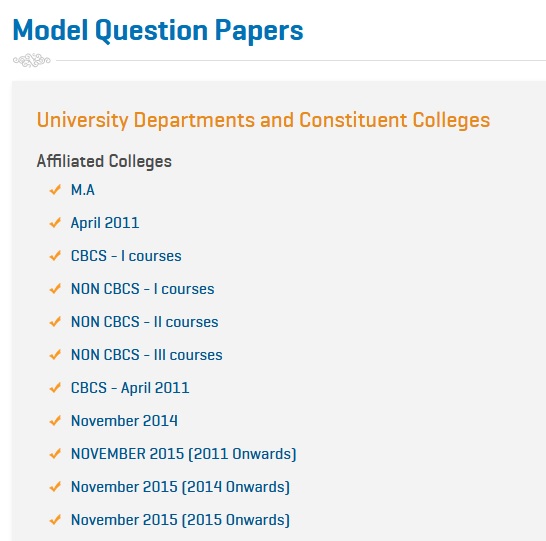Banking Law And Practice M.B.M Model Question Papers : alagappauniversity.ac.in
Name of the University : Alagappa University
Degree : M.B.M
Subject Code/Name : Banking Law And Practice
Document Type : Model Question Papers
Website : alagappauniversity.ac.in
Download Model/Sample Question Paper : https://www.pdfquestion.in/uploads/alagappauniversity.ac.in/4285.-MBM.pdf
Alagappa University Banking Law Question Paper
M.B.M. DEGREE EXAMINATION, DECEMBER 2011.
Time : Three hours
Maximum : 100 marks
Related : Alagappa University Management Process MIBA Model Question Papers : www.pdfquestion.in/4167.html
Answer any FIVE questions.
1. What are the innovative services rendered by banks-
2. “A Banker is bound to honour his customer cheques”-
3. What do you understand by non-resident accounts-
4. Explain the merits of stock exchange securities as security –
5. Explain the factors limiting the level of banks advances.

6. Distinguish between cheque, bill of exchange and promissory note.
7. Bring out the different kinds of endorsement.
8. What are the features of Fixed Deposit Receipt-
9. Describe in detail the role played by banks in developing
10. Define the terms “BANKER” and “CUSTOMER”
11. Discuss the formalities which a banker has to observe
12. State the precautions that a banker should take
13. What are the essential features of a promissory note-
14. Discuss the statutory protection available to a collecting banker.
Central Banking & Monetary Management
M.B.M. DEGREE EXAMINATION, DECEMBER 2011.
Time : Three hours Maximum : 100 marks
Answer any FIVE questions.
1. Enumerate the causes of under developed money market.
2. Point out the characteristics of a central bank.
3. What are open market operations- State their limitations.
4. Critically evaluate the efficacy of monetary policy.
5. Explain the need for banking education.
6. Briefly state the organisational structure and evolution of RBI.
7. Write a note on credit planning in India.
8. How does RBI promote industrial finance- Explain.
9. Explain in detail the functions of a central bank.
10. ‘Deposits create credit; credit creates deposits’
11. Assess the role of central bank in a developing economy.
12. State and explain the objectives of monetary policy.
13. What are the regulations relating to capital reserves
14. Narrate the RBI’s instruments of general credit control.
Rural Banking
M.B.M. DEGREE EXAMINATION, DECEMBER 2011.
Answer any FIVE questions.
1. Explain the importance of rural banking.
2. What are the sources of finance in rural areas-
3. Bring out the role of IRDP in poverty alleviation.
4. Comment on the outcome of 20-point economic programme.
5. State the objectives of Lead Bank.
6. Mention the salient features of District Credit plan.
7. List out the functions of SIDBI.
8. Enlist the problems faced by Khadi and Village Industries
9. Describe the role of commercial banks in developing rural areas.
10. What are the functions of regional rural banks-
11. Explain the concept of ‘‘priority sector’’.
12. Explain the role of lead bank and member banks.
13. Bring out the uses and importance
14. Explain the objectives and functions of DIC.
Essentials of Management
M.B.M. DEGREE EXAMINATION, DECEMBER 2011.
Answer any FIVE questions.
1. Explain the essentials for effective bank management.
2. Describe the role of a bank manager.
3. Explain the nature and significance of bank objectives.
4. What are the various types of committees-
5. Enumerate the principles of direction.
6. How do you measure profitability in banks?
7. Discuss the process of manpower planning in banks.
8. What are the principles of delegation?
PART B : (4 × 15 = 60 marks)
Answer any FOUR questions.
9. Write an essay on environment for effective bank management.
10. Describe the process of decision making in banks.
11. Explain the merits and demerits of decentralization of authority.
12. Discuss the steps in conflict management in banks.
13. Distinguish between productivity and profitability in banks.
14. Explain the procedure for handling employee grievances redressal.
Computers & Banking
M.B.M. Degree Examination, December 2011 :
Time : Three hour
Maximum : 100 marks
PART A : (5 × 8 = 40 marks)
Answer any FIVE questions.
All questions carry equal marks.
1. Explain the features of a digital computer.
2. Explain Binary System with examples.
3. What are the objectives of data processing?
4. Explain RAM and ROM.
5. What is the need for programming language?
6. What are the functions of an operating system?
7. What are the features of intranet?
8. What are the benefits of ATMs?
Part B : (4 × 15 = 60 marks)
Answer any FOUR questions.
All questions carry equal marks.
9. Explain different generations of computers.
10. How does a computer work? Explain with the help of a block diagram.
11. What are the features of high level language?
12. Explain different types of networks.
13. How are inter-branch transactions carried out with the help of computers in banks?
14. What are the likely problems that affect the working of computers?
I can’t download the questions. Please help me.